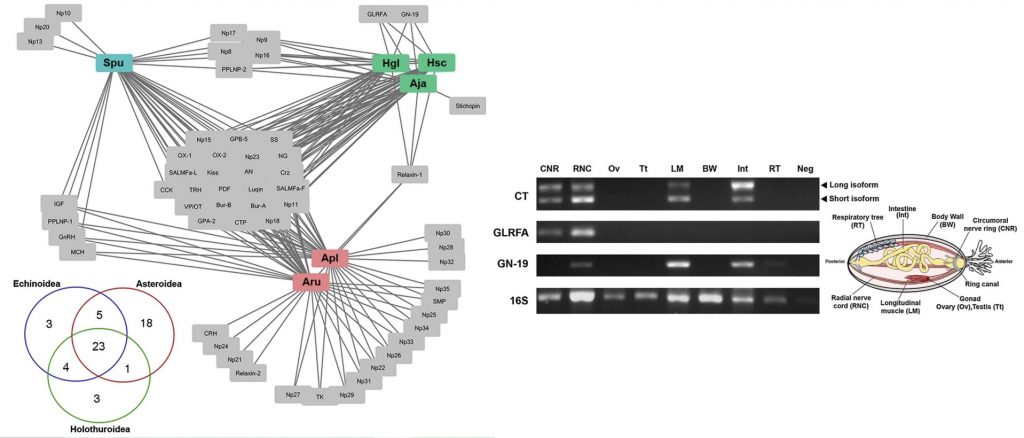
การศึกษาเปรียบเทียบ Transcriptome ของ neuropeptide precursors ในปลิงทะเล Holothuroidea
Highlight:
ในการศึกษานี้ คณะผู้วิจัยได้ค้นพบและทำการศึกษา Transcriptome sequencing ของปลิงทะเลขาวกลุ่ม Holothuroidea Holothuria scabra และได้ศึกษาคุณลักษณะของ putative neuropeptides ใน H. scabra และ H. graberrima transcriptomes. นอกจากนี้ยังได้ทำการศึกษาและวิเคราะห์เปรียบเทียบ และศึกษาการแสดงออกของ holothurian specific neuropeptides.
ที่มาและความสำคัญ
ในปัจจุบัน ได้มีความสนใจในการบริโภคปลิงทะเลเพิ่มขึ้น เนื่องจากว่า คุณสมบัติทางโภชนาการของปลิงทะเลมีประโยชน์ต่อสุขภาพอย่างมาก รวมทั้งการป้องกันหรือรักษาโรคต่างๆ ดังนั้น การศึกษาที่ผ่านมามุ่งเน้นไปที่การทำความเข้าใจชีววิทยาของปลิงทะเลเพื่อปรับปรุงการเพาะเลี้ยงสัตว์น้ำ อาทิ การใช้ neuropeptides เพื่อเพิ่มการเจริญเติบโตและการสืบพันธุ์ อย่างไรก็ตาม ได้มีการสำรวจ neuropeptidome ของปลิงทะเล Apostichopus japonicus ซึ่งมีการวิเคราะห์และระบุการถอดรหัส แต่ยังไม่มีการศึกษาใน H. scabra เลย ดังนั้นในการศึกษานี้ เราทำการวิเคราะห์ in silico ของ H. scabra transcriptomes ที่ได้มาจาก วงแหวนประสาท เส้นประสาทเรเดียล รังไข่ และ RNA ของเนื้อเยื่ออัณฑะ นอกจากนี้เรายังเปรียบเทียบการค้นพบของเราจาก H. scabra กับข้อมูลที่ได้จากสายพันธุ์ที่เกี่ยวข้องอย่างใกล้ชิด H. glaberrima และนำมาเปรียบเทียบกับข้อมูลจาก echinoderms และ bilaterians อื่น ๆ ทำให้สามารถระบุถึงการกระจายของสายวิวัฒนาการอย่างกว้างขวางซึ่งอาจเป็นเอกลักษณ์ของ echinoderms อื่นๆโดยเฉพาะในปลิงทะเล
Abstract
Neuropeptides synthesized and released by neuronal cells play important roles in the regulation of many processes, e.g. growth, feeding, reproduction, and behavior. In the past decade, next-generation sequencing technologies have helped to facilitate the identification of multiple neuropeptide genes in a variety of taxa, including arthropods, molluscs and echinoderms. In this study, we extend these studies to Holothuria scabra, a sea cucumber species that is widely cultured for human consumption. In silico analysis of H. scabra neural and gonadal transcriptomes enabled the identification of 28 transcripts that encode a total of 26 bilaterian and echinoderm-specific neuropeptide precursors. Furthermore, publicly available sequence data from another sea cucumber, Holothuria glaberrima, allowed a more in-depth comparative investigation. Interestingly, two isoforms of a calcitonin-type peptide precursor (CTPP) were deduced from the H. scabra transcriptome – HscCTPP-long and HscCTPP-short, likely the result of alternative splicing. We also identified a sea cucumber relaxin-type peptide precursor, which is of interest because relaxin-type peptides have been shown to act as gonadotropic hormones in starfish. Two neuropeptides that appear to be holothurian-specific are GLRFA, and GN-19. In H. scabra, the expression of GLRFA was restricted to neural tissues, while GN-19 expression was additionally found in the longitudinal muscle and intestinal tissues. In conclusion, we have obtained new insights into the neuropeptide signaling systems of holothurians, which will facilitate physiological studies that may enable advances in the aquaculture of sea cucumbers.
Keywords: Neuropeptides, Transcriptomes, Nervous tissue, Gonads, Echinoderm Holothuria scabra
Citation: Suwansa-ard S, Chaiyamoon A, Talarovicova A, Tinikul R, Tinikul Y, Poomtong T, Elphick MR, Cummins SF, Sobhon P (2018) Transcriptomic discovery and comparative analysis of neuropeptide precursors in sea cucumbers (Holothuroidea). Peptides 99C: 231-240.
http://dx.doi.org/10.1016/j.peptides.2017.10.008
RELATED SDGs:
14. LIFE BELOW WATER

ผู้ให้ข้อมูล: รองศาสตราจารย์ ดร.ยสวันต์ ตินิกุล
ชื่ออาจารย์ที่ทำวิจัย: รองศาสตราจารย์ ดร.ยสวันต์ ตินิกุล
ชื่อนักศึกษาที่ทำวิจัย: นางสาวเสาวรส สุวรรณสะอาด นางสาวอารดา ไชยมูล
แหล่งทุนวิจัย: Agricultural Research Development Agency
Tags: Echinoderm Holothuria scabra, Gonads, Nervous tissue, Neuropeptides, Transcriptomes
